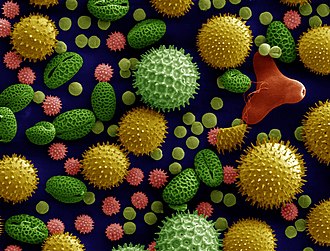Pollen
Pollen[edit]

Pollen is a fine to coarse powdery substance comprising pollen grains, which are male microgametophytes of seed plants, responsible for the production of male gametes (sperm cells). Each pollen grain contains a vegetative (non-reproductive) cell, and a generative (reproductive) cell that divides to form two sperm cells.
Structure[edit]

Pollen grains have a hard coat made of sporopollenin that protects the gametophytes during the process of their movement from the stamens to the pistil of flowering plants, or from the male cone to the female cone of coniferous plants. The structure of pollen grains varies among species, which can be used to identify the plant species from which they originate.
Function[edit]
The primary function of pollen is to transfer male genetic material from one plant to another, facilitating fertilization and the production of seeds. Pollen is produced in the anthers of the stamens in angiosperms and in the microsporangium of gymnosperms.
Pollen Tube[edit]

Once a pollen grain lands on a compatible stigma, it germinates and grows a pollen tube down the style to the ovule. The sperm cells travel through this tube to reach the egg cell, resulting in fertilization.
Types of Pollen[edit]

Pollen can be classified based on its source plant. For example, pollen from angiosperms is often sticky and heavy, adapted for transport by animals, while pollen from gymnosperms is typically lighter and adapted for wind dispersal.
Pollen Viability[edit]

Pollen viability refers to the ability of pollen to germinate and effect fertilization. Factors affecting viability include environmental conditions, storage, and the age of the pollen.
Pollen and Pollination[edit]

Pollination is the process by which pollen is transferred from the male part of a plant to the female part, enabling fertilization. This can occur via wind, water, or animals, with insects being the most common pollinators.
Pollen Development[edit]

Pollen development begins with the formation of microspores in the anthers. These microspores undergo mitosis to form pollen grains, which are released when the anther dehisces.
Related Pages[edit]
Ad. Transform your life with W8MD's Budget GLP-1 injections from $75


W8MD offers a medical weight loss program to lose weight in Philadelphia. Our physician-supervised medical weight loss provides:
- Weight loss injections in NYC (generic and brand names):
- Zepbound / Mounjaro, Wegovy / Ozempic, Saxenda
- Most insurances accepted or discounted self-pay rates. We will obtain insurance prior authorizations if needed.
- Generic GLP1 weight loss injections from $75 for the starting dose.
- Also offer prescription weight loss medications including Phentermine, Qsymia, Diethylpropion, Contrave etc.
NYC weight loss doctor appointmentsNYC weight loss doctor appointments
Start your NYC weight loss journey today at our NYC medical weight loss and Philadelphia medical weight loss clinics.
- Call 718-946-5500 to lose weight in NYC or for medical weight loss in Philadelphia 215-676-2334.
- Tags:NYC medical weight loss, Philadelphia lose weight Zepbound NYC, Budget GLP1 weight loss injections, Wegovy Philadelphia, Wegovy NYC, Philadelphia medical weight loss, Brookly weight loss and Wegovy NYC
|
WikiMD's Wellness Encyclopedia |
| Let Food Be Thy Medicine Medicine Thy Food - Hippocrates |
Medical Disclaimer: WikiMD is not a substitute for professional medical advice. The information on WikiMD is provided as an information resource only, may be incorrect, outdated or misleading, and is not to be used or relied on for any diagnostic or treatment purposes. Please consult your health care provider before making any healthcare decisions or for guidance about a specific medical condition. WikiMD expressly disclaims responsibility, and shall have no liability, for any damages, loss, injury, or liability whatsoever suffered as a result of your reliance on the information contained in this site. By visiting this site you agree to the foregoing terms and conditions, which may from time to time be changed or supplemented by WikiMD. If you do not agree to the foregoing terms and conditions, you should not enter or use this site. See full disclaimer.
Credits:Most images are courtesy of Wikimedia commons, and templates, categories Wikipedia, licensed under CC BY SA or similar.
Translate this page: - East Asian
中文,
日本,
한국어,
South Asian
हिन्दी,
தமிழ்,
తెలుగు,
Urdu,
ಕನ್ನಡ,
Southeast Asian
Indonesian,
Vietnamese,
Thai,
မြန်မာဘာသာ,
বাংলা
European
español,
Deutsch,
français,
Greek,
português do Brasil,
polski,
română,
русский,
Nederlands,
norsk,
svenska,
suomi,
Italian
Middle Eastern & African
عربى,
Turkish,
Persian,
Hebrew,
Afrikaans,
isiZulu,
Kiswahili,
Other
Bulgarian,
Hungarian,
Czech,
Swedish,
മലയാളം,
मराठी,
ਪੰਜਾਬੀ,
ગુજરાતી,
Portuguese,
Ukrainian